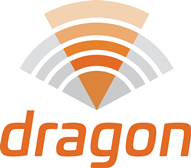
On May 20th, 2021, the DRAGON project and part of the achievements have been presented by Nicolas Cassiau, Loïc Marnat, ( CEAT (Fr) ) to the JOURNÉE GDR-ISIS ON ‘’ENABLING TECHNOLOGIES FOR (SUB)-TERAHERTZ COMMUNICATIONS, an event supported by the French Research project ANR-BRAVE (Dec 2020).
The title of the talk and abstract are reported below.
Beam alignment strategy under hardware constraints for D-Band
communications (the DRAGON project)
Nicolas Cassiau, Lo¨ıc Marnat
CEA-Leti, Universit ´e Grenoble Alpes, F-38000 Grenoble, France,
nicolas.cassiau@cea.fr
The DRAGON project1 aims at demonstrating a high capacity D-band (130-174.8 GHz) wireless back/front haul solution able to address the needs of 5G transport networks. A pole-mounted transceiver will be designed and implemented, including baseband modem, radio frequency frontend
and 1024-element phased array antennas. A dedicated module, the Phased Array Manager (PAM) will be responsible to control the antenna drivers and generate the desired beams. The target distance between the pole-mounted transceiver and the gNB – 100 m to 1 km – imposes very high gain antennas, and therefore the use of very narrow beams (in the order of 3.5° half-power beamwidth). This feature may cause misalignment between transmit and receive beams when poles vibrate: a measurement campaign by NOKIA [1] has shown that poles can experience sways and twists with up to 5° and 1° amplitude respectively, with a frequency of up to 5 Hz. In this context, the PAM role is select the best antenna beam (i.e. the one that maximizes the received power) at all time to ensure a valid communication link and a minimum QoS. In DRAGON, CEA is responsible for the PAM design, implementation and integration into the transceiver. The strategy to determine the best beam is to use dedicated time slots – Beam Alignment (BA) fields – during which the received power level (RSL) is measured for several beams. The beam that provides the highest RSL is then selected. The design of the algorithm is constrained by (i) the hardware (HW) used for the modem and the antenna drivers (and their interfaces with the PAM), (ii) the need to minimize the overhead dedicated to beam assessment and (iii) the actual movement of the antenna. (i) The main limitation imposed by the HW is the time required to ‘load’ the coefficients of a new beam into the antenna drivers: 256 phases and amplitudes (one couple applied to 4 antenna elements) must be written through SPIs. It requires about Tload = 2=FP ms with FP being the serial clock frequency in MHz (typically ranging from 1 to 10 MHz). This means that only one beam, different from the current used one, can be assessed every Tload ms. (ii) By increasing the serial clock frequency (e.g. to 10 MHz), beams can be assessed more frequently, but this would come with more frequent BA fields and thus with a net throughput loss. A compromise must therefore be found between the periodicity of BA fields and the accuracy of the beam alignment. (iii) This sizing is realized thanks to a software tool specifically developed for the DRAGON project. This tool provides the gain of any beam for a given antenna in the direction of interest (azimuth and elevation) over time, for a set a parameters including: twist and sways amplitudes and frequencies, pole vibration plane, distance and heights of the transmitter and receiver antennas. We show that with typical vibrations specified in [1], Tload = 2 ms provides satisfactory results. The HW implementation of the PAM is currently under study. A codebook of beams will be
defined (thanks to the software tool presented above) and stored in an external memory. A code embedded in a FPGA will access this codebook, and will interface with the baseband modem and the antenna drivers.
[1] Rashid Kalimulin et al. “Impact of mounting structures twists and sways on point-to-point millimeter-wave backhaul links,” in: International Conference on Communication Workshop (ICCW) (2015).

Comments are closed.